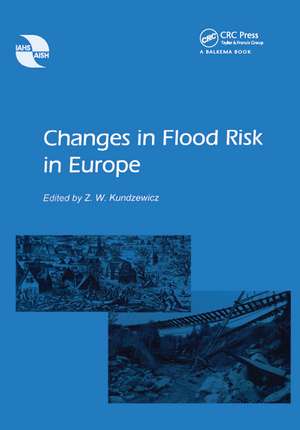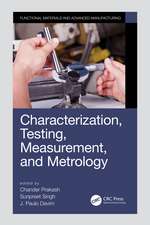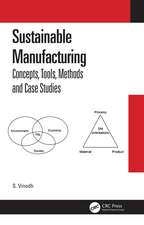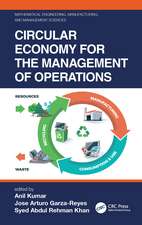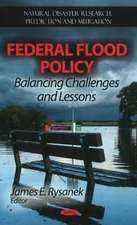Changes in Flood Risk in Europe
Editat de Zbigniew W. Kundzewiczen Limba Engleză Hardback – 2 oct 2019
Preț: 995.57 lei
Preț vechi: 1334.83 lei
-25% Nou
Puncte Express: 1493
Preț estimativ în valută:
190.53€ • 197.91$ • 158.26£
190.53€ • 197.91$ • 158.26£
Carte tipărită la comandă
Livrare economică 03-17 februarie 25
Preluare comenzi: 021 569.72.76
Specificații
ISBN-13: 9781138475205
ISBN-10: 1138475203
Pagini: 536
Dimensiuni: 174 x 246 mm
Greutate: 1.02 kg
Ediția:1
Editura: CRC Press
Colecția CRC Press
ISBN-10: 1138475203
Pagini: 536
Dimensiuni: 174 x 246 mm
Greutate: 1.02 kg
Ediția:1
Editura: CRC Press
Colecția CRC Press
Public țintă
ProfessionalCuprins
1 Introduction/Zbigniew W. Kundzewicz -- 1.1 Preliminaries -- 1.2 Structure of the Book -- 1.3 Flood Risk Change -- 1.4 Concluding Remarks -- I FACETS OF CHANGE -- 2 Changes in Flood Risk - Setting the Stage/Zbigniew W. Kundzewicz, Erich J. Plate, Harvey J. E. Rodda,John C. Rodda, Hans Joachim Scheilnhuber & Witold G. Strupczewski -- 2.1 Introduction -- 2.2 Flood Risk -- 2.3 Multi-causality -- 2.4 Recent Changes in Flood Risk -- 2.5 Adaptation - Flood Risk Reduction -- 2.6 Concluding Remarks -- 3 Catalogue of Large Floods in Europe in the 20th Century/Adam Choryñski, lwona Piñskwar, Wolfgang Kron, G. Robert Brakenridge & Zbigniew W. Kundzewicz -- 3.1 Introduction and Outline -- 3.2 Sources of Information -- 3.3 Known Errors and Uncertainties -- 3.4 The Flood Catalogue -- 3.5 Concluding Remarks -- 4 Large-scale Flooding in Europe, 1961-2005/Christel Prudhomme, Simon Parry, Marie Genevier, Jamie Hannaford & Zbigniew W. Kundzewicz -- 4.1 Introduction -- 4.2 A Catalogue of European Regional High Flows, 1961-2005 -- 4.3 Flood Peaks and Preceding Circulation Types: Relationships in Europe -- 5 Changing Floods in Europe/lwona Piñskwar, Zbigniew W. Kundzewicz, Pascal Peduzzi,G. Robert Brakenridge, Kerstin Stahl & Jamie Hannaford -- 5.1 Introduction -- 5.2 Observed Development of Climatic Drivers -- 5.3 Changes in River Discharge -- 5.4 Changes in Maximum Flow -- 5.5 Exposure to Floods -- 5.6 Changes in Flood Risk in Europe -- 5.7 Concluding Remarks -- 6 Changes in Intense Precipitation in Europe/Olga Zolina -- 6.1 Introduction -- 6.2 Data for Estimation of Intense Precipitation -- 6.3 Absolute Precipitation Extremes over Europe -- 6.4 Climate Tendencies in the Relative Precipitation Extremeness over Europe -- 6.5 Changes in Temporal Structure of European Precipitation -- 6.6 Summary and Conclusions -- 7 Historical Floods in Europe in the Past Millennium/Rudolf Brázdil, Zbigniew W. Kundzewicz, Gerardo Benito, Gaston Demarée, Neil Macdonald & Lars A. Roald -- 7.1 Introduction -- 7.2 Beginnings of Instrumental Hydrological Measurements -- 7.3 Documentary Data about Floods -- 7.4 Historical Floods in Europe in the Past Millennium -- 7.5 Discussion -- 7.6 Conclusions -- II NATIONAL AND REGIONAL PERSPECTIVES ON FLOODS -- 8 Floods in Austria -- 8.1 Günter Blõschl, RalfMerz, Juraj Parajka, José Salinas & Alberto Viglione -- 8.2 Introduction -- 8.3 Flood Processes in Austria -- 8.4 Changes of Floods in the Past -- 9 Predictability of Flood Changes Floods in the Czech Republic/ R. Brázdil, L Reznicková, M. Havlícek & L Elleder -- 9.1 Introduction -- 9.2 Hydrological Observations -- 9.3 Changes of Factors Influencing Floods 1901-2010 -- 9.4 Frequency and Magnitude of Floods, 1901-2010 -- 9.5 The Most Disastrous Floods, 1901-2010 -- 9.6 Floods in the Context of the Changing Environment: Discussion -- 9.7 Conclusions -- 10 Floods in France/Ignazio Giuntoli, Benjamin Renard & Michel Lang -- 10.1 Introduction -- 10.2 The Data Set -- 10.3 Methods -- 10.4 Results -- 10.5 Conclusions -- 11 Flood Risk from a Holistic Perspective - Observed Changes in Germany/Fred F. Hattermann, Zbigniew W. Kundzewicz, Shaochun Huang, Tobias Vetter,Wolfgang Kron, Olaf Burghoff, Bruno Merz, Axel Bronstert, Valentina Krysanova,Friedrich-Wilhelm Gerstengarbe, Peter Werner & Ylva Hauf -- 11.1 Introduction and Outline -- 11.2 Climate and Hydrological Characteristics of Germany -- 11.3 Data and Methodology -- 11.4 Changes of Factors Driving Flood Hazard -- 11.5 Non-climatic Drivers of Flood Hazard: Land-use Change and River Training Effects -- 11.6 River Discharge -- 11.7 Flood Damage -- 11.8 Concluding Remarks -- 12 Floods in Greece/D. Koutsoyiannis, N. Mamassis, A. Efstratiadis, N. Zarkadoulas & I. Markonis -- 12.1 Introduction -- 12.2 Reflections from the Past: Analysis of Palaeofloods -- 12.3 Reflections from the Past: Flood Mythology -- 12.4 Reflections from the Past: Flood Control in Greek Antiquity -- 12.5 Modern Greece: Positive and Negative Experiences -- 12.6 Concluding Remarks -- 13 Floods in Iceland/Ami Snorrason, Bergur Einarsson, Emmanuel Pagneux, Jórunn Hardardóttir,Matthew J. Roberts, Oddur Sigurdsson, Óõinn Thórarinsson,Philippe Crochet, Tomas Jóhannesson & Thorsteinn Thorsteinsson -- 13.1 Introduction -- 13.2 Types of Floods in Iceland -- 13.3 Case Studies -- 13.4 Concluding Remarks -- 14 Flood Risk in Italy/Paola Salvati, Cinzia Bianchi, Mauro Rossi & Fausto Guzzetti -- 14.1 Introduction -- 14.2 Record of Harmful Flood Events in Italy -- 14.3 Risk Evaluation -- 14.4 Comparison to Other Natural Hazards -- 14.5 Conclusions -- 15 Floods in The Netherlands/J. K. Vrijling -- 15.1 Introduction -- 15.2 Chronology of Major Flood Events -- 15.3 Conclusions -- 16 Floods in Norway/Lars Andreas Roald -- 16.1 Introduction -- 16.2 Winter Floods -- 16.3 Snowmelt Spring Floods -- 16.4 Summer Rainfall Floods -- 16.5 Autumn Floods -- 16.6 Ice-run Floods -- 16.7 Floods from Glacier-dammed Lakes - Jókullhlaup -- 16.8 Trends in Streamflow and the Occurrence of Floods -- 16.9 Update-Floods in 2011 -- 17 Floods in Poland/Zbigniew W. Kundzewicz, Andrzej Dobrowolski, Halina Lorenc,Tadeusz Niedzwiedz, lwona Piñskwar & Piotr Kowalczak -- 17.1 Introduction -- 17.2 Hydrography of Poland in a Nutshell -- 17.3 Climatic Drivers -- 17.4 Causes of Floods in Poland and their Spatial and Temporal Distribution -- 17.5 Chronology of Floods in Poland -- 17.6 Concluding Remarks -- 18 Floods in Switzerland/Petra Schmocker-Fackel & Felix Naef -- 18.1 Introduction -- 18.2 Data and Study Site -- 18.3 Changes in Flood Frequency since 1850 -- 18.4 Atmospheric Circulation and Floods -- 18.5 Changes in Flood Frequency since 1500 -- 18.6 Concluding Remarks -- 19 Flood Risk in the UK: Evidence of Change andManagement Responses/Jamie Hannaford & Jim W. Hall -- 19.1 Introduction -- 19.2 Background: Climate, Hydrology and Flooding -- 19.3 Recent Major Floods in the UK -- 19.4 Observed Climate Changes Relevant to Flooding -- 19.5 Trends in Fluvial Flooding -- 19.6 Links Between Flooding and Atmospheric Circulation -- 19.7 A Longer-term Perspective -- 19.8 Changes in Flood Risk and Flood Risk Management -- 19.9 Concluding Remarks -- 20 Floods in the Alpine Areas of Europe/Antoine Bard, Benjamin Renard & Michel Lang -- 20.1 Introduction -- 20.2 The Data Set -- 20.3 Methods -- 20.4 Results -- 20.5 Conclusions -- 21 Floods in the Iberian Peninsula/Gerardo Benito & Maria J. Machado -- 21.1 Introduction -- 21.2 Flood Hydroclimatology -- 21.3 Observed Flood Records -- 21.4 Socio-economic Losses Due to Flooding -- 21.5 Discussion and Conclusions -- III DETECTION AND ATTRIBUTION OF CHANGE, AND PROSPECTS -- 22 Detection of Changes/Sheng Yue, Zbigniew W. Kundzewicz <& Linghui Wang -- 22.1 Introduction -- 22.2 Statistical Principles for Trend Detection -- 22.3 Site Significance Tests -- 22.4 Field Significance Tests -- 22.5 Pitfalls in Trend Detection -- 22.6 Procedures for Trend Detection -- 23 Detection and Attribution of Climate Change and Its/Zbigniew W. Kundzewicz & Wolfgang Cramer -- 23.1 Introduction -- 23.2 Attribution of Global Warming in a Multi-factor Context -- 23.3 Controversy about Detection and Attribution of Climate Change -- 23.4 Detection and Attribution of Climate Change Impacts -- 23.5 Concluding Remarks -- 24 Detection and Attribution of Changes in Water Resources/Dieter Gerten, Wolfgang Lucht & Zbigniew W. Kundzewicz -- 24.1 Introduction -- 24.2 What Influences Global River Discharge? -- 24.3 Uncertainties in Estimates of Precipitation and River Flow -- 24.4 The Model and Data Used, and Simulations Performed for this Study -- 24.5 Results and Discussion -- 24.6 Conclusion -- 25 Detection and Attribution of Changes in Flood Hazard and Risk/Bruno Merz, Zbigniew W. Kundzewicz, Jose Delgado, Yeshewa Hundecha &Heidi Kreibich -- 25.1 Introduction -- 25.2 Drivers of Changing Flood Hazard and Risk -- 25.3 Changes in Flood Hazard -- 25.4 Changes in Vulnerability and Risk -- 25.5 Climate Change and Flood Trends -- 25.6 Conclusions -- 26 Changing Flood Risk - A Re-insurer's Viewpoint/by Wolfgang Kron -- 26.1 Introduction -- 26.2 Flood Disasters and Flood Losses in Europe -- 26.3 Types of Flood -- 26.4 Reasons for the Increasing Flood Risk -- 26.5 Flood Risk Reduction -- 26.6 Final Remarks -- 27 Projections of Flood Risk in Europe by Christel Prudhomme, Jennifer Williamson, Simon Parry & European Regional High Flow Catalogue Simulated from Observed Climate -- 27.1 The Future of Regional High Flows in Europe: Results from WATCH -- 27.2 Simulations -- Index.
Notă biografică
Zbigniew W. Kundzewicz is an authority on floods and climate change, works closely with the IPCC (Intergovernmental Panel of Climate Change), is a member of the Advisory Board on the Environment of the European Union Seventh Framework Programme, and is the co-editor of Hydrological Sciences Journal. He is a Corresponding Member of the Polish Academy of Sciences (PAS), Professor of Earth Sciences and Head of the Department of Climate and Water Resources at the Institute for Agricultural and Forest Environment, PAS, Poznan, Poland, and an associate of the Potsdam Institute for Climate Impact Research (PIK), Potsdam, Germany.
Recenzii
The book provides challenging data for an audience whose interest is in controlling water and perhaps, especially, for those involved with the “Building – Working – Engineering with Nature” movements.
The stated aim of the book is to make as much national information as possible available to a broad, international readership so that comparisons, syntheses and knowledge exchange can lead to a better understanding of what future flood risks may be and how we can best prepare for them.
Terra et Aqua, Number 128, September 2012, p30
The stated aim of the book is to make as much national information as possible available to a broad, international readership so that comparisons, syntheses and knowledge exchange can lead to a better understanding of what future flood risks may be and how we can best prepare for them.
Terra et Aqua, Number 128, September 2012, p30
Descriere
This book delivers a wealth of information on changes in flood risk in Europe, and considers causes for change. The temporal coverage is mostly focused on post-1900 events, reflecting the typical availability of data, but some information on earlier flood events is also included.
